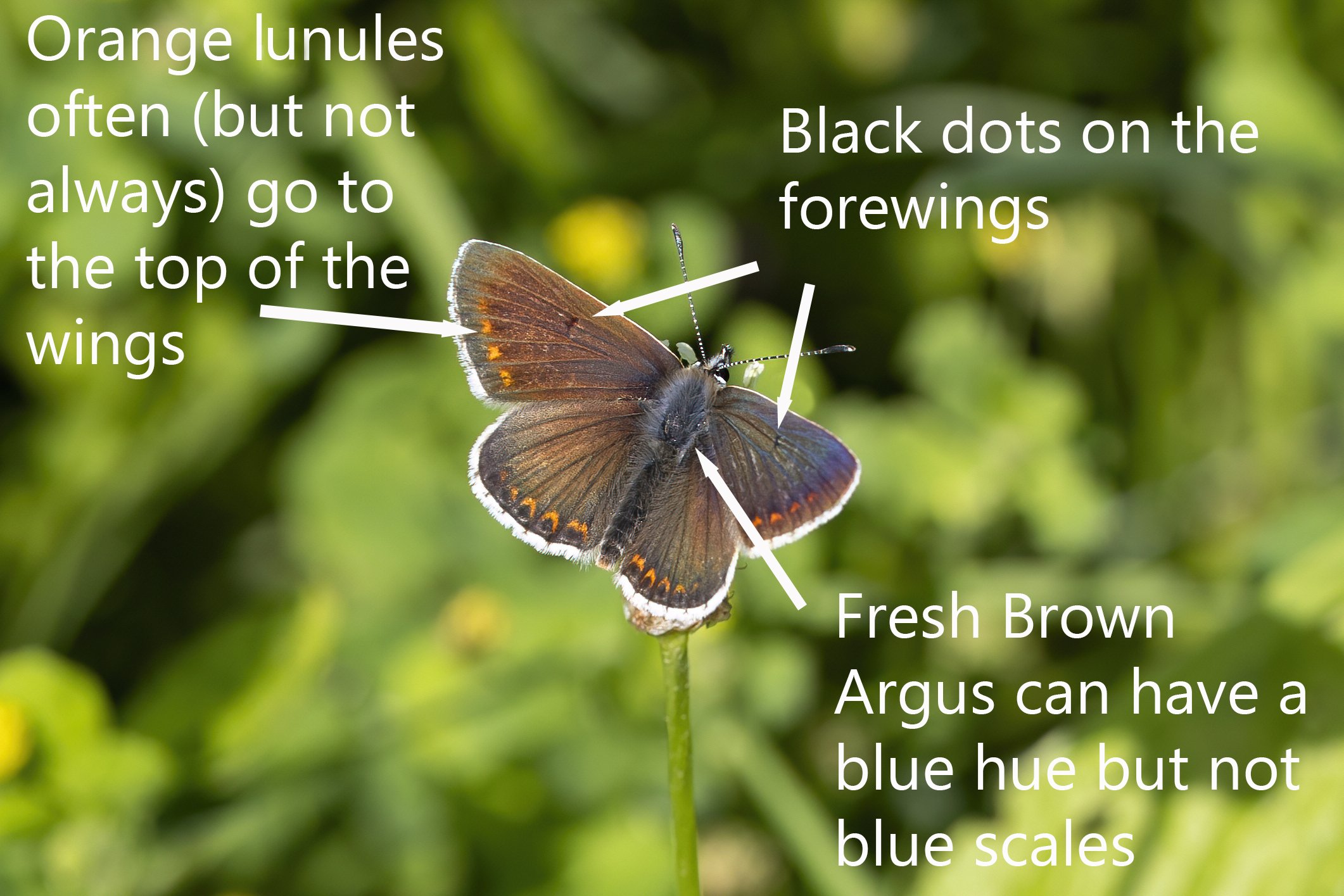Identifying Confusion Species - The Blues
The identification of the Blues can be a bit tricky and some species, such as the Brown Argus and the female Common Blue can look remarkably similar! One of the most often encountered Blues, especially when they are having a good season, is the Holly Blue as this is the one most likely to be seen in our gardens and parks. However, the Holly Blue can sometimes be confused with the Common Blue, especially by beginners. The behaviour of the two butterflies is normally very different, the Common Blue is a grassland species whereas the Holly Blue likes to fly around bushes and trees. Although this rule cannot be 100% relied upon the butterfly flying along the top of your Ivy clad wall is far more likely to be a Holly Blue than a Common Blue, likewise the Blue butterfly flying through the middle of a meadow is more likely to be a Common Blue rather than a Holly Blue. To be absolutely confident in a correct identification you do of course need to see the butterfly settled so can look for the distinguishing features. As always with butterfly identification a pair of close-focusing binoculars and photography can help you to study the butterflies without disturbing them. Holly Blues can sometimes also get confused with Small Blues but remember that not only is the Small Blue a grassland species, it is also considerably smaller than the Holly Blue and not only that it has been extinct in Northamptonshire for many years. When viewing the underwing the Holly Blue is quite unmistakable, it has a pale blue base colour with small black dots as seen in the photograph below.
Holly Blue
The Holly Blue’s upperwings, especially of the female, are also very distinctive. The female Holly Blue has a rich blue colour and a large dark marking on the outer edges of the forewings. The pale borders surrounding the upper forewings also have dark lines going across them giving a chequered appearance as seen in the photo below.
Holly Blue
The male Holly Blue also has dark markings on the far outer edges of the upper forewings but they’re not as pronounced as the females. Like the female, the male also has the dark bands going across the pale borders of the forewings as seen in the photo below.
Holly Blue
Moving on to the Common Blue the upperwings of the male can look quite similar to the male of the Holly Blue. However, male Common Blues have no dark markings on the upper forewings and the border is a plain pale colour with no dark bands going across it as seen in the photo below.
Common Blue
The underwings of the Common Blue are significantly different to the Holly Blue and should pose no problems at all with separating the two species. However, we now come across the next identification challenge which involves separating the Common Blue and the Brown Argus. Both the Common Blue and the Brown Argus fly at the same time and as they are both grassland species they also occupy the same habitat. The easiest way of telling the two species apart is to study the underwings. The underwings of the Common Blue and the Brown Argus have a series of white spots with black centres. The Common Blue only has one spot at the rear of the leading edge of the hindwing, and it also has a single spot on the inner half of the underside of the forewing as shown in the photo below.
Common Blue
Now compare the above photo of the Common Blue with the photo below of the Brown Argus. The big difference between the two species involves that spot on the rear of the leading edge of the hindwing. In the Brown Argus, there is another spot very close to it and this forms the distinctive “figure of eight” mark which will tell you that this is a Brown Argus and not a Common Blue. The Brown Argus also lacks the spot on the inner half of the forewing.
Brown Argus
Separating the Common Blue and Brown Argus when only the upperwings are in view can be more problematic as Common Blue females can be very variable in their colouration and the dark forms can look remarkably like the Brown Argus. One thing to remember is the Brown Argus, while sometimes giving off a blue sheen, never has blue scales scattered on the wings like the female Common Blue has. The female Common Blue also has white scales on the lunules that run along the lower edge of the hindwing and they lack the distinctive black spots in the middle of the forewings as seen in the photo below.
Brown Argus
The Brown Argus has distinctive black dots in the middle of the forewings and the orange lunules along the outer edges of the wings are much more distinctive. In the females these lunules go all the way to the tops of the wings but in the males they tend to be slightly less well marked as they reach the tops of the wings. As seen in the photo below, the Brown Argus also can give off a blue sheen, especially when freshly emerged, but they lack the blue scales of the Common Blue.
Brown Argus








